WMG News
Warwick’s Wonka explores the world of pure imagination
 Professor of Visualisation, Alan Chalmers, an expert in flavour simulation at WMG at the University of Warwick, discusses the most famous creations of Willy Wonka ahead of the film premiere this December.
Professor of Visualisation, Alan Chalmers, an expert in flavour simulation at WMG at the University of Warwick, discusses the most famous creations of Willy Wonka ahead of the film premiere this December.
“While we may not have discovered the source of snozzberries, our research invites everyone to wonder about the extraordinary possibilities within the science of flavours” – Professor Chalmers.
Professor Chalmers is the creator of an exciting new flavour experience in a virtual way, with the opportunity to taste almost anything in a sip. The process takes samples of food for analysis, to accurately simulate a real flavour by extracting its tastes, aromas, and mouthfeel. His research has placed him as Warwick’s Willy Wonka.
“We can take a person on a journey through the vast flavour space from the start flavour to a variant that they enjoy”.
Three-course meal bubble-gum:
“Flavour is just the sensation of the taste, aroma and mouthfeel of food or drink in your mouth. If you take the real food or drink and analyse them to extract these components – then they can simply be authentically simulated with UK Food Standards Agency food-safe chemicals.
“So, you take a fork full of roast turkey, gravy, Brussel sprouts and a bit of roast potato … and analyse it with specialist devices to extract exactly what the taste, aroma and mouthfeel components are for this food ensemble. Once you have this “recipe” you simply recreate this exact flavour with the food-safe chemicals – with a specific food-safe chemical for each component, for example, sucrose is used to simulate the sweetness component.
The correct combinations of these chemicals can then be embedded in chewing gum … and voila – as you bite down on the chewing gum – you will experience the same flavour – as if you just had eaten the real roast turkey, gravy, Brussel sprouts and roast potato.”
Lick-able Wallpaper:
“This would be quite straightforward to do. You simply need to embed the food-safe chemicals for each of the components of the desired flavour into the wallpaper – and as it is licked – so the flavour will be perceived.”
The Everlasting-gobstopper:
“I could imagine a ball of eg hard plastic which is impregnated with a sweet flavour. The sweet won’t get smaller - but at some point the sweet flavour will have to be replenished. This will depend how often the gobstopper is sucked and how hard! I could imagine the centre of the plastic ball contains the liquid and this is drawn out as the person sucks. The liquid could be replaced when required.
“Not sure it is a sweet I would want – I think I will stick to chocolate!”
ENDS
Notes to editors
For further information please contact
Bron Mills
bron.mills@warwick.ac.uk
07824540720
The technology was not originally created with inspiration from the infamous chocolatier. The theory behind the invention is that changes in a person's taste and smell senses could be an early indication of Alzheimer’s before signs of memory loss arise. The easy-to-use low-cost dispenser could be used by a nurse as part of an annual health check, in pharmacies, care homes, community centres and even in the home. Researchers hope to achieve UK-wide screening services where members of the public can take a simple smell and taste test. Those who perform poorly can then be referred for further tests which could result in an Alzheimer’s diagnosis.
Professor Chalmers said: “At the moment, people who present with symptoms of memory loss are referred for MRI scans and spinal fluid tests to confirm a diagnosis. By the time memory loss occurs, things are often too late; pioneering drug treatments only perform well in the early stages of degeneration.
WMG research helps develop new generation of graphene composites
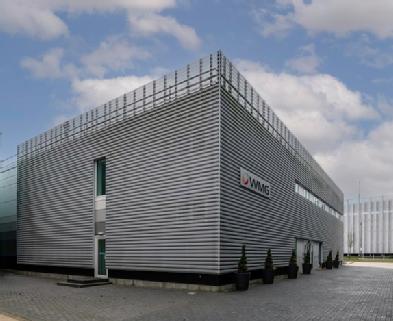 Researchers at WMG, University of Warwick’s, International Institute for Nanocomposites Manufacturing (IINM) have been working with the team at Versarien plc on a new comprehensive portfolio of graphene and related nanomaterial based thermoplastic polymer compounds and masterbatches.
Researchers at WMG, University of Warwick’s, International Institute for Nanocomposites Manufacturing (IINM) have been working with the team at Versarien plc on a new comprehensive portfolio of graphene and related nanomaterial based thermoplastic polymer compounds and masterbatches.
The new PolygreneTM compounds are expected to have potential commercial applications in areas as diverse as sports equipment, construction products, aerospace and automotive components.
Since 2018, Versarien subsidiary 2-DTech Ltd (2DT), Composites UK member, has funded PhD and postdoctoral researchers to understand the use of its Nanene™ graphene powders and other nanomaterials in thermoplastic systems. Dr David Reinoso-Arenas, the first 2DT funded PhD student, with support from the EPSRC Doctoral Training Programme, worked with Versarien’s Nanene™ materials in thermoplastic elastomer (TPE) systems and joined Versarien full-time last year as part of the team at Versarien’s subsidiary Cambridge Graphene Ltd.
Dr David Reinoso-Arenas, explained: “The new PolygreneTM thermoplastics portfolio is a culmination of my PhD research, some of which is due to be published in peer-reviewed journals. Since then we’ve been able to further develop and test these materials using different nanomaterial fillers and process conditions to fully optimise the resulting product performance. My PhD experience at the IINM and WMG was really enjoyable and enabled me to work closely with industry to ensure that the outputs of my research could be validated and have commercial viability.”
David’s PhD was performed under the supervision of Professor Tony McNally, whose team has an established capability in incorporating a wide range of nanomaterials into bulk polymer systems.
Professor Tony McNally, who leads the Nanocomposites Research Group at WMG, University of Warwick, said: “Working with Versarien over the last few years has given the IINM and WMG access to alternative graphene materials that have shown interesting phenomena when blended in these TPE systems. By tuning the nanofiller loading and optimising process conditions, David’s research showed that exceptional gains can be achieved in mechanical properties across the board (tensile strength, modulus, elongation at break, toughness and abrasion resistance) without compromising any properties. The addition of graphene also highlights improvements in polymer processing which may offer lower energy usage and, therefore, improving sustainability.”
Professor McNally continues to work with Versarien by providing a funded PhD position in 2D material based rubber systems, making use of the IINM’s new state of the art rubber processing and testing capabilities With support from the High Value Manufacturing Catapult (HVMC), WMG has established a world class facility for the study of elastomers.
Dr Stephen Hodge, Versarien’s CEO, added: “We look forward to continuing our collaboration with the IINM and WMG in rubber processing and understanding the interactions of our graphene and other 2D materials in these more complex systems, and hope to be able to demonstrate significant benefits that can impact upon real-world applications.”
Find out more and download technical datasheets here: https://versarienproducts.co.uk/thermoplastics
Find out more about WMG’s Nanocomposites research here:https://warwick.ac.uk/fac/sci/wmg/research/materials/nanocomposites/
Expert comment from Shravani Sharma
Shravani Sharma, Researcher at WMG at the University of Warwick, comments on the news that the Government is to cancel rail industry plans to close the vast majority of railway station ticket offices in England.
vast majority of railway station ticket offices in England.
Shravani Sharma, whose recent work focused on the impact of travel on those with disabilities, said: “It’s a relief to hear of the U-turn of the ticket office closures. Through working with a range of disability charities, it’s clear that the removal of ticket offices would have a profound impact on the disabled. Working with CASBA (Citizen Advocacy South Birmingham Area), which supports people with learning difficulties, Royal National Institute of Blind People (RNIB) and Cerebral Palsy Midlands has shed light on the problems removing the ticket offices would have on the disabled.
“People with different visible and non-visible disabilities – including blindness, mobility problems, hearing loss, cerebral palsy and ADHD amongst others – would be severely impacted by the loss of ticket offices. People could be challenged by the technology, unable to distinguish train tickets from receipts, or simply need the guidance or assistance of a ticket officer.
“The U-turn will be a relief for so many people across the UK. When planning policies for the transport industry, people from a wide range of backgrounds, with different needs, must be properly listened to before making any big decisions. I would urge the government to consult both disability charities and the disabled in future policymaking.”
Expert comment from Professor Siddartha Khastgir
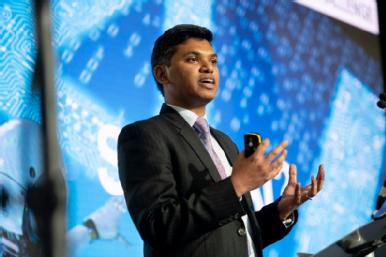 Professor Siddartha Khastgir, Head of Verification and Validation at WMG, University of Warwick, comments on Cruise pausing all driverless robotaxi operations in the US to rebuild public trust.
Professor Siddartha Khastgir, Head of Verification and Validation at WMG, University of Warwick, comments on Cruise pausing all driverless robotaxi operations in the US to rebuild public trust.
“Safety is the number one priority when commercialising self-driving vehicles, we should never compromise safety even though this is a fast-paced technology. The industry and autonomous vehicle developers and operators need to have a thorough review of the current incidents and be more open and transparent regarding their safety assurance processes and systems.
“Safety messages and information should be communicated to the public to gradually build up societal trust and ensure that technology users and road users are well-informed about this new technology’s capabilities and limitations.
“As a world-leading research institution, WMG is working closely with international and national policymakers, regulators, and industry to improve the safety of self-driving vehicles. We encourage the ecosystem to collaborate further to gain the public’s confidence in this emerging transport technology.”
Find out more about WMG’s Verification and Validation research here: https://warwick.ac.uk/fac/sci/wmg/research/cav/vandv/
WMG research shapes the future of autonomous vehicles
WMG, at the University of Warwick, is part a unique £2 million consortium, entitled Sim4CAMSens.
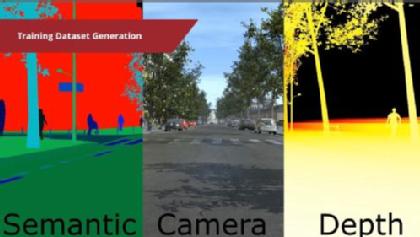 The Sim4CAMSens project, led by Claytex, is made up of a consortium of prominent industry partners, including AESIN, rFpro, Syselek, Oxford RF, National Physical Laboratory, Compound Semiconductor Applications Catapult and WMG.
The Sim4CAMSens project, led by Claytex, is made up of a consortium of prominent industry partners, including AESIN, rFpro, Syselek, Oxford RF, National Physical Laboratory, Compound Semiconductor Applications Catapult and WMG.
Together the consortium will create a framework for sensor evaluation that incorporates modelling, simulation, and actual testing. In order to enable Automated Driving Systems (ADS) and sensor developers to speed their development, this project will involve the development of new models for sensors, noise and materials, and new test methodologies.
The role of WMG will be to understand which noise factors have the higher impact on the different perception sensors (i.e., camera, LiDAR, RADAR,) and how to correlate virtual testing to real-life testing to support the entire supply chain.
Professor Valentina Donzella, who leads the Intelligent Vehicles Sensors research at WMG explains: “The Sim4CAMSens project is an extremely exciting opportunity for WMG, to work with UK based world leading industrial and research partners, to speed up the development of sensors models and testing methodologies. These are key considerations for the future safe deployment of robust and reliable ADS. The success of this project will ensure the UK leads the way globally in this field."
Find out more about WMG’s Intelligent Vehicles Sensors research here: https://warwick.ac.uk/fac/sci/wmg/research/cav/ivsensors
WMG with Solihull Council secure £300,000 for self-driving shuttle feasibility study
WMG at The University of Warwick, Solihull Council, National Highways, Transport for West Midlands, ZF, Aurrigo, Syselek and Liftango have successfully secured £300,000 to deliver a project looking into the feasibility of a self-driving shuttle service in the West Midlands.
The project will explore how a new automated transport link between Blythe Valley Business Park, near Shirley, and the new HS2 rail station in Solihull could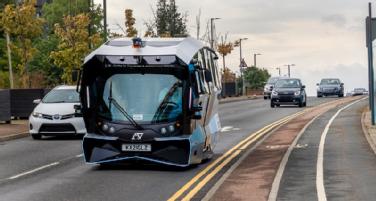 operate in the future. The feasibility study will consider all aspects of the technology required in order to provide a safe and reliable automated public transport service between these important commercial centres. The proposed route would use the existing road network travelling along the M42 from Junction 4 and utilise the new Junction 5a currently under construction.
operate in the future. The feasibility study will consider all aspects of the technology required in order to provide a safe and reliable automated public transport service between these important commercial centres. The proposed route would use the existing road network travelling along the M42 from Junction 4 and utilise the new Junction 5a currently under construction.
As a world-class research institution with leading capabilities in the verification and validation of safety assurance of self-driving technologies, WMG will apply its Operational Design Domain (ODD) based Safety Assurance research methodologies to the specific project challenges.
This project is part of the wider Midlands Future Mobility (MFM) initiative, led by WMG. The MFM vision is to achieve zero road incidents, net-zero emissions and inclusive transport in the West Midlands. MFM enables stakeholders from across mobility to address the interlinked challenges of technology, policy, and behaviour to realise the vision.
Cllr Ken Hawkins, Solihull Council Cabinet Member for Environment & Infrastructure, said: “Connected Automated Vehicle (CAV) technology has the potential revolutionise the way we get around our towns, cities and rural areas. Working with our partners we are excited to be undertaking this latest project.
“We’ve already carried out a series of successful pathfinder trials here in Solihull, using our own automated shuttle, and have led the way in showing how it is possible to practically and safely incorporate automated vehicles into our existing transport infrastructure. We are now taking the next step and undertaking the vital feasibility work necessary in order to start thinking about more ambitious deployments and establishing new commercial public transport services.
“The outcomes from the study are likely to inform self-driving mobility challenges not just here in Solihull but nationwide.”
Jonathan Smith, Midlands Future Mobility Programme Manager said: "The business case for scaling new mobility solutions is complex. It involves a granular understanding of the use case, safety, users, operations, and infrastructure. This project brings together a group of diverse experts to apply state of the art research and knowledge to address this question. Of critical importance is that the outcomes of this feasibility will inform mobility business cases both in the Midlands and the UK as a whole."
More information about this project
Partners: Solihull Metropolitan Borough Council (Lead), Aurrigo, Syselek (Uk) Ltd, Liftango Ltd, ZF Services UK Limited, West Midlands Combined Authority, Highways England, University of Warwick
Grant awarded: £300,000 (£197,664 from Centre for Connected and Autonomous Vehicles’ Commercialising Connected and Automated Mobility programme and balance is made up by the commercial partners).
Find out more about WMG’s Validation and Verification research here: Verification and Validation (warwick.ac.uk)
Note to editors
Media contact:
Annie Slinn
Communications Officer (Sciences)
Gabbie Lau
WMG Marketing and Communications Executive
WMG joins flagship electrification partnership
WMG at the University of Warwick, is part of a unique six-way partner collaborative research and development project led by Aston Martin.
Project ELEVATION has received £9m funding from the Advanced Propulsion Centre UK (APC) to supplement the research and development of Aston Martin’s in-house bespoke luxury battery electric vehicle platform.
Awarded following a competitive process, the government grant will support the development of Aston Martin’s luxury BEV platform and enable a route to net-zero, including investment in vehicle light weighting, a digital toolchain and electrification training.
Project ELEVATION is led by Aston Martin, and supported by the Manufacturing Technology Centre; Expert Tooling & Automation; Creative Composites; Fuzzy Logic Studio and WMG. The project will address the technical challenges of developing a lightweight, 800V traction battery pack and twin front electric drive unit (EDU) into a modular BEV platform with a bandwidth from supercar to SUV.
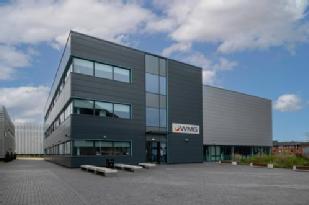 WMG’s role will focus on supporting the design, manufacture and life-cycle analysis (LCA) of the modular structural composite battery enclosure. Researchers in the composites group based in WMG's Materials Engineering Centre (MEC) will conduct materials evaluation and investigate automated high-volume composite manufacturing of hybrid structures using existing tooling and equipment to demonstrate attributes on early learning components. This knowledge will then be transferred to Creative Composites for manufacture of the project demonstrator components and provide LCA of the composite structure into the Manufacturing Technology Centre's holistic LCA model.
WMG’s role will focus on supporting the design, manufacture and life-cycle analysis (LCA) of the modular structural composite battery enclosure. Researchers in the composites group based in WMG's Materials Engineering Centre (MEC) will conduct materials evaluation and investigate automated high-volume composite manufacturing of hybrid structures using existing tooling and equipment to demonstrate attributes on early learning components. This knowledge will then be transferred to Creative Composites for manufacture of the project demonstrator components and provide LCA of the composite structure into the Manufacturing Technology Centre's holistic LCA model.
Roberto Fedeli, Group Chief Technology Officer of Aston Martin, said: “The award of funding from the APC is another major boost to our electrification strategy and constant strive for innovation. Providing further resources to explore the possibilities of our bespoke BEV platform, it will help achieve our ambition to be an in-house BEV technology leader in the ultra-luxury, high-performance segment. We look forward to progressing this project with our collaborative partners and thank the APC for their incredible support.”
Ian Constance, APC Chief Executive, said: “The 23rd round of our collaborative R&D competition coincides with the APC’s 10th anniversary. We’ve seen over £1.4 billion of investment into automotive projects since the APC was set up, and I am proud of the impact that we have made here in the UK. This latest announcement includes a diverse set of OEMs and suppliers that demonstrate the strength of UK automotive. They will further add to our portfolio of innovative projects and continue to drive the UK to deliver on its net zero ambition.”
Find out more about WMG’s composite light-weighting research here https://warwick.ac.uk/fac/sci/wmg/research/materials/acrc
University of Warwick scientists create virtual marmite for World Marmite Day – with ground-breaking potential for Alzheimer’s diagnosis
Scientists at WMG at the University of Warwick have produced virtual flavours of marmite and vegemite from scratch, using technology that can replicate the flavour of almost any food or drink and is being used in a new taste test to help with early Alzheimer’s diagnosis.
WMG’s Professor of Visualisation, Alan Chalmers has created the virtual flavours for World Marmite Day (28th September) and can, through taking samples of a food and analysing it, accurately simulate a real flavour by extracting its tastes, aromas, and mouthfeel.
The analysis is done by New-Food Innovation, a high-tech food company. Once analysed the virtual flavours are created to accurately match the real flavour using UK Food Standards Agency approved food-safe chemicals.
The analyses/ investigations are all part of Professor Chalmers’ research, together with West Midlands company Superlunary Labs, into how people perceive taste and smell.
He is also investigating whether a poor performance on the new ‘taste test’ that he has developed, may be an early warning signs for diseases including dementia. This could lead to a much earlier diagnosis of diseases such as Alzheimer’s Disease, well before any memory loss starts to occur.
Professor Chalmers describes the flavour making process as the same as using a recipe – by accurately simulating the different components of a flavour, food such as marmite can be replicated with a taste indistinguishable from the real thing.
He commented: “We recreated the health drink rooibos tea and even the chief taster of a rooibos manufacturer in South Africa could not distinguish between the real and virtual rooibos.
“I first thought of creating the samples of marmite and vegemite for a bit of fun during the Ashes cricket tests this summer as people kept asking - what is the difference between them?
“It goes back to the serious work we’re doing which shows that people’s taste and smell can give us clues what’s going on in a person’s brain years before symptoms such as memory loss start”.
Malcolm Barnes from Superlunary Labs added: “We work alongside Professor Chalmers to ensure virtual flavours are delivered from an easy to use, hygienic and highly calibrated device for Chalmers’ team to analyse.’
The full paper on the technology behind this process can be found here.
Read more about WMG’s Visualisation research here: Visualisation (warwick.ac.uk)
Self-driving cars will be part of the future – but researchers fear we are leaving the disabled behind
 Self-driving cars will be part of the future, but researchers fear people with disabilities are being left behind in the development of the technology.
Self-driving cars will be part of the future, but researchers fear people with disabilities are being left behind in the development of the technology.
Over the past two decades, transportation has become more accessible, but people with disabilities still face significant barriers to accessing these services. While self-driving cars (also known as autonomous vehicles) have the potential to dramatically improve the lives of those with disabilities, helping them to travel independently, experts fear their views are being neglected in the development of the new technology
To address this, researchers from WMG at The University of Warwick and leading disability charities have considered the impact of self-driving taxis on people with disabilities, an area that has seen limited improvement over recent years.
They found that the absence of a driver was strongly correlated with feelings and perceptions of increased travel freedom, indicating that autonomous taxis could provide greater accessibility for those with disabilities – without the limitations or biases associated with their current experiences with traditional taxis and drivers.
The team also considered current issues people who have disabilities face with transport – particularly in booking taxi journeys. Participants expressed concerns about driver attitudes and behaviour as negative experiences with traditional taxis.
Lead author Shravani Sharma, PhD Researcher, WMG, University of Warwick, said: “Our research highlights the current issues those with disabilities face when booking taxis – with many reporting that their trips have been cancelled due to their use of a wheelchair. Drivers might feel the extra time wheelchairs add to journeys would reduce their earnings. While there are laws in place preventing black cab drivers cancelling journeys for those with wheelchairs – there are no such laws for other companies.
“Self-driving taxis could provide those with disabilities more freedom and reduce fear of discrimination. So, it’s crucial we listen to their opinions in developing the technology.
“We worked with charities including CASBA (Citizen Advocacy South Birmingham Area), which supports people with learning difficulties, Royal National Institute of Blind People (RNIB) and Cerebral Palsy Midlands to name a few, providing a wide range of voices and expertise. This represented many different visible and non-visible disabilities – including blindness, mobility problems, hearing loss, cerebral palsy and ADHD amongst others. The perspectives of more than 39,000 different organisation members were included.
“Alongside the current problems those with disabilities face when booking taxis, we highlighted their concerns for future, self-driving taxis. The main concern was the availability of human assistance to meet specific user needs throughout the journey.”
Examples of concerns for future, self-driving taxis:
- The challenges faced by individuals in wheelchairs when attempting to enter a car without assistance are multifaceted. Tasks include placing their wheelchair inside the car, securing themselves within it, disassembling and carefully navigating the wheelchair upon departure.
- For those with visual impairments, the struggle lies in identifying their vehicle within a crowded setting, such as a bustling railway station.
- The loss of social interactions and the light-hearted atmosphere during journeys. Many individuals with disabilities unfortunately contend with feelings of loneliness and isolation, making everyday conversations a vital source of companionship and comfort throughout their journey.
Shravani added: “It is also important that manufacturers consider the wide range of disabilities and the intricate needs for passengers – remembering that not all disabilities are visible.”
Dr Roger Woodman, Head of Human Factors, at the University of Warwick, said: “Self-driving vehicles will open up driving to people that have never been on their own in a vehicle before. It has the potential to transform their lives – with reduced reliance on others to help them get from A to B.
“Driving is a very complex task to complete, so self-driving cars could enable someone with a disability, for example, cerebral palsy or tremors, to simply press a button and go.
Ginny Cullen, CEO of CASBA, added: “CASBA exists to ensure people with learning disabilities speak up for themselves, express their views, make their choices, and are valued as citizens. We were therefore delighted to have had the opportunity to be included in this research on new autonomous vehicles to ensure driving is accessible to all.”
CASE STUDIES – both available for media interviews upon request
Jen Brown
“I have a lot of trouble with the buses. I use a walker and they don’t lower the bus, making it very hard for me to get on and off.
“I had a lot of stress with a taxi company. I often travel from Kingstanding to Northfield. The taxi company didn’t want to take the job and sometimes cancelled, leaving me stressed and late for work. Sometimes I was not able to get home from work.
“I went to a food show in November, when I got to the station the lift was out of order. I walked round the station looking for staff to help, no one and there was no one in the office. I phoned mom and dad see if they could find a number. I had to end up putting my walker on the escalator which was very dangerous.
“I nearly got locked on the train once. I have regular visits to the Severn Valley Railway and am used to the journey. When got to Snow Hill the train stopped, and I thought it was waiting for the signal. People started to get off the train, and I didn’t know why, I decided to get off and just as I did the lights went off and the doors closed. It said on the screen it was cancelled and with my hearing impairment I couldn’t hear the announcement.
Jen added her thoughts on what difference self-driving taxis would make to her life. She said: “When I finish work, I feel very tired and don’t want to talk. I just want to relax on my way home. Also, with my hearing impairment if the windows are open, I can’t hear the driver and just guess as what he is saying. Self-driving taxis would cause me less stress and worry as I wouldn’t have to worry about what the driver is saying to me.”
Michaela Mooney
“I think some people misjudge invisible disability. I may look like I can do things like everyone else but it has a high energy cost for me; my joints hurt and sometimes dislocate so when there's no seats on a bus it can be a struggle. I fall over a lot, sometimes slam doors by accident and when people don't understand what happens it can be hard mentally and physically. I think a self-driving car would mean more independence as you don't have to depend on someone to get around.”
Notes to Editors
Shravani’s research also highlights:
- This is the right time to involve many such organisations that work with people with disabilities to understand user needs via consultations, pilots, and testing.
- Presently, autonomous vehicles and other transport related studies primarily focus on addressing physical disabilities. This emphasis is evident even in signage, consistently featuring wheelchair symbols. However, the breadth of this spectrum encompasses a wide array of conditions. Consequently, it is imperative for brands to acknowledge and cater to these varied requirements and this research can be a basepoint for such engagements.
- This type of research of understanding user-specific needs and requirements will be useful for many such emerging technologies for the equitable rate of adoption to reach the overarching goal of inclusivity and accessibility.
- Future research will also consider more intelligent human machine interaction that can have a social touch to it, for example, personalised conversation nuances, or even adding diverse accents to computer generated voices.
WMG Professor made Fellow of the Royal Academy of Engineering
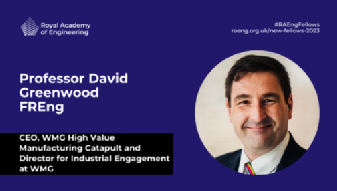 WMG at the University of Warwick’s Professor David Greenwood has been elected a Fellow of the prestigious Royal Academy of Engineering.
WMG at the University of Warwick’s Professor David Greenwood has been elected a Fellow of the prestigious Royal Academy of Engineering.
Professor Greenwood is CEO of the High Value Manufacturing Catapult and Director for Industrial Engagement at WMG.
Professor Greenwood has been elected as part of a group of 73 leading figures in the field of engineering and technology to the fellowship.
The group consists of 60 Fellows, eight International Fellows and five Honorary Fellows, each of whom has made exceptional contributions to their own sector, pioneering new innovations, leading progress in business or academia, providing high level advice to government, or promoting wider understanding of engineering and technology.
The new Fellows will be formally admitted to the Academy at a special ceremony in London on 28 November, when each Fellow will sign the roll book. In joining the Fellowship, they will lend their unique capabilities to achieving the Academy’s overarching strategic goal to harness the power of engineering to create a sustainable society and an inclusive economy for all.
Professor Greenwood commented: "I am truly honoured to be elected as a Fellow of the Royal Academy of Engineering. The UK has tremendous capability in engineering and manufacturing and the work of the Royal Academy is pivotal in helping to achieve its full potential. I look forward to playing my part in that."
Professor Sir Jim McDonald FREng FRSE, President of the Royal Academy of Engineering, said:
“Engineering is everywhere, but nowhere the same, and our new Fellows represent the great breadth and diversity of engineers who are striving to address some of the world’s most complex challenges – benefiting society and the economy in the process. From next generation power networks and water systems to quantum computing and artificial intelligence, our new Fellows are shaping the future.
“We live in an era of rapid change across our communities, our country, and of course our planet. Today we welcome to our Fellowship an inspiring group of people who are harnessing their creativity, courage and commitment to drive positive change in the world around us and we look forward to their contribution to our work.”
View the full list of 2023 fellows here.

